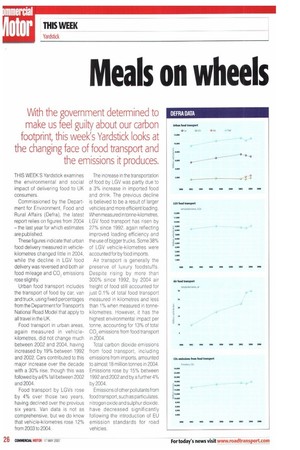Meals on wheels
Page 26

If you've noticed an error in this article please click here to report it so we can fix it.
With the government determined to make us feel guilty about our carbon footprint, this week's Yardstick looks at the changing face of food transport and the emissions it produces.
THIS WEEK'S Yardstick examines the environmental and social impact of delivering food to UK consumers.
Commissioned by the Department for Environment, Food and Rural Affairs (Defra), the latest report relies on figures from 2004 — the last year for which estimates are published.
These figures indicate that urban food delivery measured in vehiclekilometres changed little in 2004, while the decline in LGV food delivery was reversed and both air food mileage and CO2 emissions rose slightly.
Urban food transport includes the transport of food by car, van and truck, using fixed percentages from the Department for Transport's National Road Model that apply to all travel in the UK.
Food transport in urban areas, again measured in vehiclekilometres, did not change much between 2002 and 2004, having increased by 19% between 1992 and 2002. Cars contributed to this major increase over the decade with a 30% rise, though this was followed by a 6% fall between 2002 and 2004.
Food transport by LGVs rose by 4% over those two years, having declined over the previous six years. Van data is not as comprehensive, but we do know that vehicle-kilometres rose 12% from 2003 to 2004. The increase in the transportation of food by LGV was partly due to a 3% increase in imported food and drink. The previous decline is believed to be a result of larger vehicles and more efficient loading. When measured in tonne-kilometres, LGV food transport has risen by 27% since 1992, again reflecting improved loading efficiency and the use of bigger trucks. Some 38% of LGV vehicle-kilometres were accounted for by food imports.
Air transport is generally the preserve of luxury foodstuffs. Despite rising by more than 300% since 1992, by 2004 air freight of food still accounted for just 0.1% of total food transport measured in kilometres and less than 1% when measured in tonnekilometres. However, it has the highest environmental impact per tonne, accounting for 13% of total CO2 emissions from food transport in 2004.
Total carbon dioxide emissions from food transport, including emissions from imports, amounted to almost 18 million tonnes in 2004. Emissions rose by 15% between 1992 and 2002 and by a further 4°/c. by 2004.
Emissions of other pollutants from food transport, such as particulates, nitrogen oxide and sulphur dioxide, have decreased significantly following the Introduction of EU emission standards for road vehicles.






























































































































































































